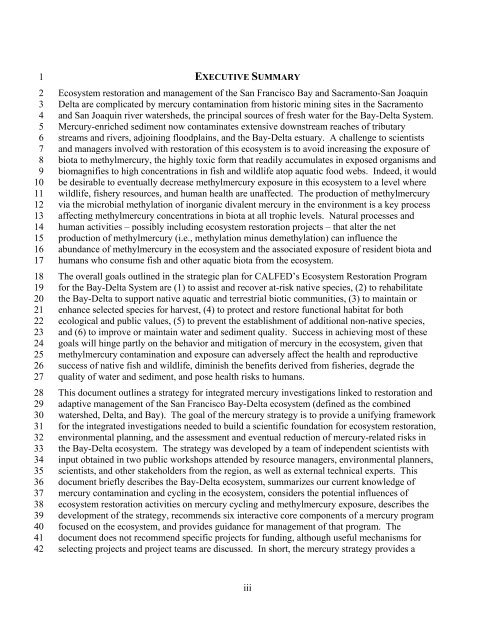Mercury Strategy for the Bay-Delta Ecosystem - CALFED Bay-Delta ...
Mercury Strategy for the Bay-Delta Ecosystem - CALFED Bay-Delta ...
Mercury Strategy for the Bay-Delta Ecosystem - CALFED Bay-Delta ...
Create successful ePaper yourself
Turn your PDF publications into a flip-book with our unique Google optimized e-Paper software.
1<br />
2<br />
3<br />
4<br />
5<br />
6<br />
7<br />
8<br />
9<br />
10<br />
11<br />
12<br />
13<br />
14<br />
15<br />
16<br />
17<br />
18<br />
19<br />
20<br />
21<br />
22<br />
23<br />
24<br />
25<br />
26<br />
27<br />
28<br />
29<br />
30<br />
31<br />
32<br />
33<br />
34<br />
35<br />
36<br />
37<br />
38<br />
39<br />
40<br />
41<br />
42<br />
EXECUTIVE SUMMARY<br />
<strong>Ecosystem</strong> restoration and management of <strong>the</strong> San Francisco <strong>Bay</strong> and Sacramento-San Joaquin<br />
<strong>Delta</strong> are complicated by mercury contamination from historic mining sites in <strong>the</strong> Sacramento<br />
and San Joaquin river watersheds, <strong>the</strong> principal sources of fresh water <strong>for</strong> <strong>the</strong> <strong>Bay</strong>-<strong>Delta</strong> System.<br />
<strong>Mercury</strong>-enriched sediment now contaminates extensive downstream reaches of tributary<br />
streams and rivers, adjoining floodplains, and <strong>the</strong> <strong>Bay</strong>-<strong>Delta</strong> estuary. A challenge to scientists<br />
and managers involved with restoration of this ecosystem is to avoid increasing <strong>the</strong> exposure of<br />
biota to methylmercury, <strong>the</strong> highly toxic <strong>for</strong>m that readily accumulates in exposed organisms and<br />
biomagnifies to high concentrations in fish and wildlife atop aquatic food webs. Indeed, it would<br />
be desirable to eventually decrease methylmercury exposure in this ecosystem to a level where<br />
wildlife, fishery resources, and human health are unaffected. The production of methylmercury<br />
via <strong>the</strong> microbial methylation of inorganic divalent mercury in <strong>the</strong> environment is a key process<br />
affecting methylmercury concentrations in biota at all trophic levels. Natural processes and<br />
human activities – possibly including ecosystem restoration projects – that alter <strong>the</strong> net<br />
production of methylmercury (i.e., methylation minus demethylation) can influence <strong>the</strong><br />
abundance of methylmercury in <strong>the</strong> ecosystem and <strong>the</strong> associated exposure of resident biota and<br />
humans who consume fish and o<strong>the</strong>r aquatic biota from <strong>the</strong> ecosystem.<br />
The overall goals outlined in <strong>the</strong> strategic plan <strong>for</strong> <strong>CALFED</strong>’s <strong>Ecosystem</strong> Restoration Program<br />
<strong>for</strong> <strong>the</strong> <strong>Bay</strong>-<strong>Delta</strong> System are (1) to assist and recover at-risk native species, (2) to rehabilitate<br />
<strong>the</strong> <strong>Bay</strong>-<strong>Delta</strong> to support native aquatic and terrestrial biotic communities, (3) to maintain or<br />
enhance selected species <strong>for</strong> harvest, (4) to protect and restore functional habitat <strong>for</strong> both<br />
ecological and public values, (5) to prevent <strong>the</strong> establishment of additional non-native species,<br />
and (6) to improve or maintain water and sediment quality. Success in achieving most of <strong>the</strong>se<br />
goals will hinge partly on <strong>the</strong> behavior and mitigation of mercury in <strong>the</strong> ecosystem, given that<br />
methylmercury contamination and exposure can adversely affect <strong>the</strong> health and reproductive<br />
success of native fish and wildlife, diminish <strong>the</strong> benefits derived from fisheries, degrade <strong>the</strong><br />
quality of water and sediment, and pose health risks to humans.<br />
This document outlines a strategy <strong>for</strong> integrated mercury investigations linked to restoration and<br />
adaptive management of <strong>the</strong> San Francisco <strong>Bay</strong>-<strong>Delta</strong> ecosystem (defined as <strong>the</strong> combined<br />
watershed, <strong>Delta</strong>, and <strong>Bay</strong>). The goal of <strong>the</strong> mercury strategy is to provide a unifying framework<br />
<strong>for</strong> <strong>the</strong> integrated investigations needed to build a scientific foundation <strong>for</strong> ecosystem restoration,<br />
environmental planning, and <strong>the</strong> assessment and eventual reduction of mercury-related risks in<br />
<strong>the</strong> <strong>Bay</strong>-<strong>Delta</strong> ecosystem. The strategy was developed by a team of independent scientists with<br />
input obtained in two public workshops attended by resource managers, environmental planners,<br />
scientists, and o<strong>the</strong>r stakeholders from <strong>the</strong> region, as well as external technical experts. This<br />
document briefly describes <strong>the</strong> <strong>Bay</strong>-<strong>Delta</strong> ecosystem, summarizes our current knowledge of<br />
mercury contamination and cycling in <strong>the</strong> ecosystem, considers <strong>the</strong> potential influences of<br />
ecosystem restoration activities on mercury cycling and methylmercury exposure, describes <strong>the</strong><br />
development of <strong>the</strong> strategy, recommends six interactive core components of a mercury program<br />
focused on <strong>the</strong> ecosystem, and provides guidance <strong>for</strong> management of that program. The<br />
document does not recommend specific projects <strong>for</strong> funding, although useful mechanisms <strong>for</strong><br />
selecting projects and project teams are discussed. In short, <strong>the</strong> mercury strategy provides a<br />
iii

















